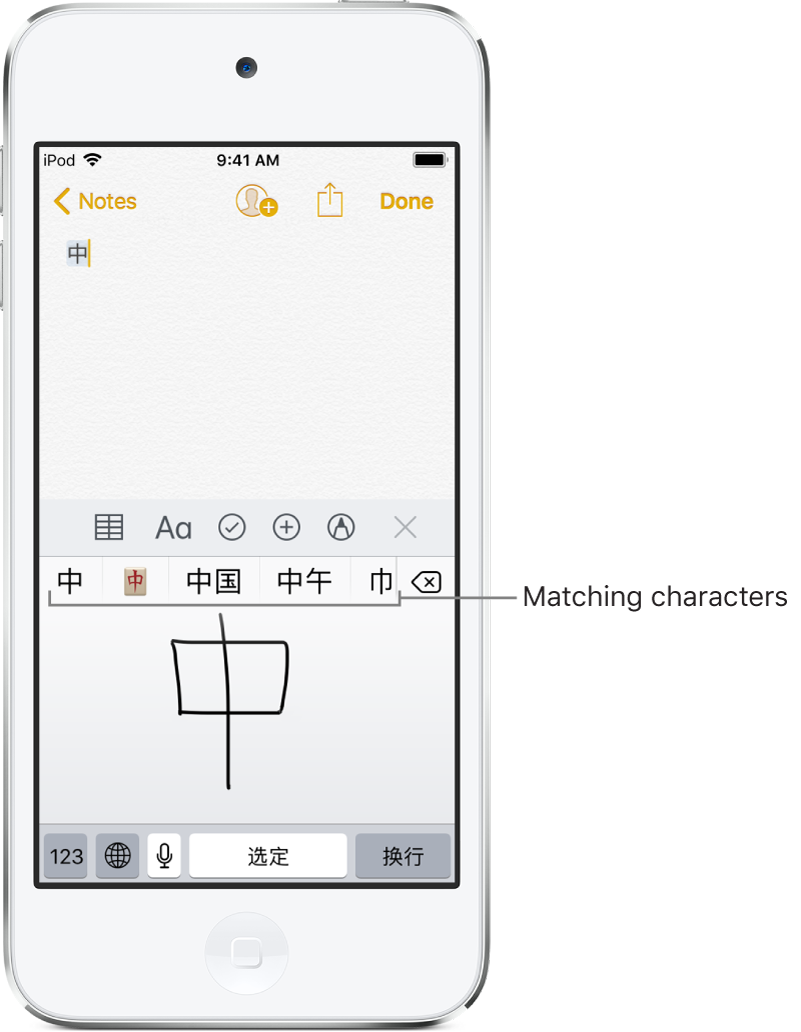iPod touch User Guide
- iPod touch User Guide
- What’s new in iOS 13
- Your iPod touch
-
- Wake and unlock
- Learn basic gestures
- Adjust the volume
- Change or turn off the sounds
- Access features from the Lock screen
- Open apps on the Home screen
- Take a screenshot or screen recording
- Change or lock the screen orientation
- Change the wallpaper
- Search with iPod touch
- Use AirDrop to send items
- Perform quick actions
- Use and customize Control Center
- View and organize Today View
- Charge and monitor the battery
- Learn the meaning of the status icons
- Travel with iPod touch
-
- Calculator
-
- View photos and videos
- Edit photos and videos
- Edit Live Photos
- Organize photos in albums
- Search in Photos
- Share photos and videos
- View Memories
- Find people in Photos
- Browse photos by location
- Use iCloud Photos
- Share photos with iCloud Shared Albums
- Use My Photo Stream
- Import photos and videos
- Print photos
- Shortcuts
- Stocks
- Tips
- Weather
-
-
- Restart iPod touch
- Force restart iPod touch
- Update iOS
- Back up iPod touch
- Return iPod touch settings to their defaults
- Restore all content from a backup
- Restore purchased and deleted items
- Sell or give away your iPod touch
- Erase all content and settings
- Restore iPod touch to factory settings
- Install or remove configuration profiles
-
- Get started with accessibility features
-
-
- Turn on and practice VoiceOver
- Change your VoiceOver settings
- Learn VoiceOver gestures
- Operate iPod touch using VoiceOver gestures
- Control VoiceOver using the rotor
- Use the onscreen keyboard
- Write with your finger
- Use VoiceOver with Magic Keyboard
- Type onscreen braille using VoiceOver
- Use a braille display
- Customize gestures and keyboard shortcuts
- Use VoiceOver with a pointer device
- Use VoiceOver in apps
- Zoom
- Magnifier
- Display & Text Size
- Motion
- Spoken Content
- Audio Descriptions
-
- Copyright
Use special input methods on iPod touch
On iPod touch, you can use special keyboards, your finger, or a stylus to enter some languages in different ways. A few examples are Chinese Cangjie and Wubihua, Japanese Kana, and Facemarks. You can also use your finger or a stylus to write Chinese characters on the screen.
Build Chinese characters from the component Cangjie keys
As you type, suggested characters appear.
To choose a character, type it, or continue typing up to five components to see more options.
Build Chinese Wubihua (stroke) characters
Use the keypad to build Chinese characters using up to five strokes, in the correct writing sequence: horizontal, vertical, left falling, right falling, and hook.
For example, the Chinese character 圈 (circle) should begin with the vertical stroke 丨.
Do any of the following:
As you type, suggested Chinese characters appear (the most commonly used characters appear first). Tap a character to choose it.
If you’re not sure of the correct stroke, enter an asterisk (*). To see more character options, type another stroke, or scroll through the character list.
Tap the match key (匹配) to show only characters that match exactly what you typed.
Write Chinese characters
Write Chinese characters directly on the screen with your finger when Simplified or Traditional Chinese handwriting input is turned on (go to Settings ![]() > General > Keyboard > Keyboards > Add New Keyboard).
> General > Keyboard > Keyboards > Add New Keyboard).
As you write character strokes, iPod touch recognizes them and shows matching characters and predictions above the handwriting area. To enlarge the handwriting area, drag the handle above the suggestions. Tap a suggestion to use it.

Type Japanese kana
Use the Kana keypad to select syllables.
For more syllable options, drag the list to the left or tap the arrow key.
Type Japanese romaji
Use the Romaji keyboard to type syllables.
Alternative choices appear along the top of the keyboard.
Tap a syllable to type it.
For more syllable options, tap the arrow key and select another syllable or word from the window.
Type facemarks or emoticons
Do one of the following:
Use the Japanese Kana keyboard: Tap
 .
.Use the Japanese Romaji keyboard: Tap
 , then tap
, then tap  .
.Use the Chinese (Simplified) Pinyin or (Traditional) Zhuyin or Pinyin keyboard: Tap
 , tap
, tap  , then tap
, then tap  .
.